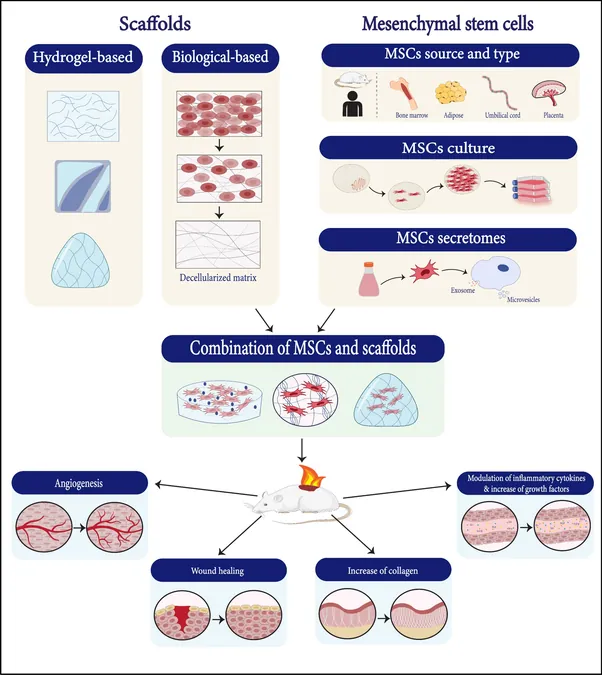
Revolutionizing Burn Healing: The Dynamic Duo of Mesenchymal Stem Cells and Scaffolds!
2025-07-01
Author: Li
Unlocking the Healing Powers of Stem Cells & Scaffolds
In the pursuit of better burn wound healing, a groundbreaking systematic review and meta-analysis have unveiled the promising effects of combining mesenchymal stem cells (MSCs) with scaffolds. This thorough research delves into preclinical studies, highlighting an innovative approach that could transform burn care.
The Study Framework: A Comprehensive Analysis
This analysis follows a meticulously structured protocol registered with PROSPERO, adhering to the PRISMA 2020 guidelines. To sift through the studies effectively, the widely accepted PICOS framework was employed, helping to pinpoint relevant research based on specified criteria.
Who Benefits from This Research?
The research primarily focuses on various mammalian species in burn injury models, excluding studies on humans or those that employ in vitro methods. A strict criterion was applied to include only studies that combined MSCs with scaffolds, discarding those that looked at other interventions.
Promises of Combining MSCs and Scaffolds
Key findings from the meta-analysis highlight that mixing MSCs with scaffolds significantly accelerates wound closure, particularly in the initial phases of healing. Observations show that this combination is most effective in the first week after injury, showcasing an astounding SMD (standardized mean difference) of 3.97!
How Does This Work? Understanding the Mechanisms
The synergistic effect is attributed to MSCs releasing numerous growth factors and cytokines that spur tissue repair and regeneration when paired with scaffolds that mimic the natural environment of the tissues. This collaboration not only enhances healing but also bolsters the structural integrity of the repaired tissues.
Navigating the Research Landscape
The study harnessed data from various robust databases and sifted through over 3,000 articles. Ultimately, 27 primary studies met the inclusion criteria, providing a wealth of information on how these combinations contribute to wound healing.
Outcomes That Matter: What Was Measured?
The study assessed key outcomes such as wound closure rates, angiogenesis (the formation of new blood vessels), collagen levels, inflammatory markers, and growth factors. The results consistently demonstrated how combining these two elements could dramatically enhance recovery.
Is There Heterogeneity? Exploring Variance Among Studies
While the overall findings are promising, the review noted high variability in the methodologies employed. This variability underscores the need for standardized approaches in future research to ensure the continued advancement of treatments.
Clinical Implications: What’s Next?
These findings are sparking excitement about the potential clinical applications of MSCs and scaffold combinations in treating burns. However, challenges like variability in study quality and treatment protocols need addressing before these therapies can be widely implemented.
A Bright Future for Burn Treatments
As researchers continue to refine these techniques, the combination of MSCs and scaffolds offers a glimmer of hope for those suffering from burn injuries. Future studies will determine how to optimize these therapies, ultimately leading to more effective and safer treatment options.
Conclusion: A New Dawn in Regenerative Medicine
The synergy between MSCs and scaffolds not only moves science forward but also brings new hope for patients in dire need of effective burn healing therapies. With continued research, this innovative combination could play a central role in revolutionizing burn care.




 Brasil (PT)
Brasil (PT)
 Canada (EN)
Canada (EN)
 Chile (ES)
Chile (ES)
 Česko (CS)
Česko (CS)
 대한민국 (KO)
대한민국 (KO)
 España (ES)
España (ES)
 France (FR)
France (FR)
 Hong Kong (EN)
Hong Kong (EN)
 Italia (IT)
Italia (IT)
 日本 (JA)
日本 (JA)
 Magyarország (HU)
Magyarország (HU)
 Norge (NO)
Norge (NO)
 Polska (PL)
Polska (PL)
 Schweiz (DE)
Schweiz (DE)
 Singapore (EN)
Singapore (EN)
 Sverige (SV)
Sverige (SV)
 Suomi (FI)
Suomi (FI)
 Türkiye (TR)
Türkiye (TR)
 الإمارات العربية المتحدة (AR)
الإمارات العربية المتحدة (AR)